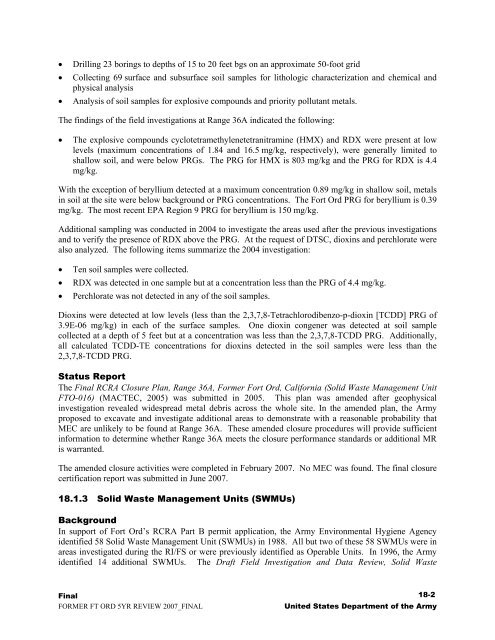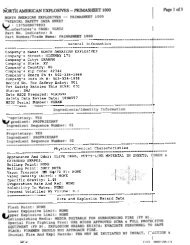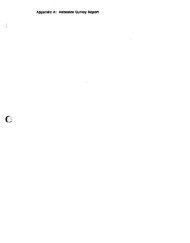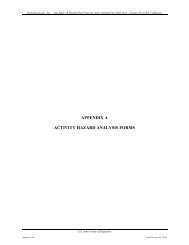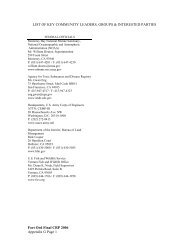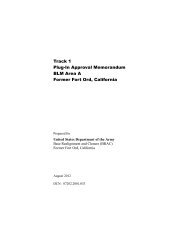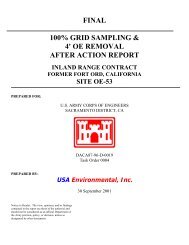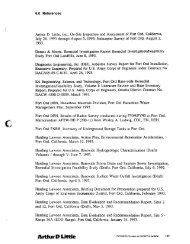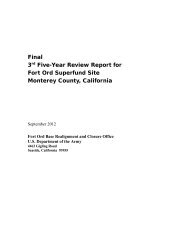Final Second Five-Year Review Report Fort Ord Superfund Site ...
Final Second Five-Year Review Report Fort Ord Superfund Site ...
Final Second Five-Year Review Report Fort Ord Superfund Site ...
Create successful ePaper yourself
Turn your PDF publications into a flip-book with our unique Google optimized e-Paper software.
• Drilling 23 borings to depths of 15 to 20 feet bgs on an approximate 50-foot grid<br />
• Collecting 69 surface and subsurface soil samples for lithologic characterization and chemical and<br />
physical analysis<br />
• Analysis of soil samples for explosive compounds and priority pollutant metals.<br />
The findings of the field investigations at Range 36A indicated the following:<br />
• The explosive compounds cyclotetramethylenetetranitramine (HMX) and RDX were present at low<br />
levels (maximum concentrations of 1.84 and 16.5 mg/kg, respectively), were generally limited to<br />
shallow soil, and were below PRGs. The PRG for HMX is 803 mg/kg and the PRG for RDX is 4.4<br />
mg/kg.<br />
With the exception of beryllium detected at a maximum concentration 0.89 mg/kg in shallow soil, metals<br />
in soil at the site were below background or PRG concentrations. The <strong>Fort</strong> <strong>Ord</strong> PRG for beryllium is 0.39<br />
mg/kg. The most recent EPA Region 9 PRG for beryllium is 150 mg/kg.<br />
Additional sampling was conducted in 2004 to investigate the areas used after the previous investigations<br />
and to verify the presence of RDX above the PRG. At the request of DTSC, dioxins and perchlorate were<br />
also analyzed. The following items summarize the 2004 investigation:<br />
• Ten soil samples were collected.<br />
• RDX was detected in one sample but at a concentration less than the PRG of 4.4 mg/kg.<br />
• Perchlorate was not detected in any of the soil samples.<br />
Dioxins were detected at low levels (less than the 2,3,7,8-Tetrachlorodibenzo-p-dioxin [TCDD] PRG of<br />
3.9E-06 mg/kg) in each of the surface samples. One dioxin congener was detected at soil sample<br />
collected at a depth of 5 feet but at a concentration was less than the 2,3,7,8-TCDD PRG. Additionally,<br />
all calculated TCDD-TE concentrations for dioxins detected in the soil samples were less than the<br />
2,3,7,8-TCDD PRG.<br />
Status <strong>Report</strong><br />
The <strong>Final</strong> RCRA Closure Plan, Range 36A, Former <strong>Fort</strong> <strong>Ord</strong>, California (Solid Waste Management Unit<br />
FTO-016) (MACTEC, 2005) was submitted in 2005. This plan was amended after geophysical<br />
investigation revealed widespread metal debris across the whole site. In the amended plan, the Army<br />
proposed to excavate and investigate additional areas to demonstrate with a reasonable probability that<br />
MEC are unlikely to be found at Range 36A. These amended closure procedures will provide sufficient<br />
information to determine whether Range 36A meets the closure performance standards or additional MR<br />
is warranted.<br />
The amended closure activities were completed in February 2007. No MEC was found. The final closure<br />
certification report was submitted in June 2007.<br />
18.1.3 Solid Waste Management Units (SWMUs)<br />
Background<br />
In support of <strong>Fort</strong> <strong>Ord</strong>’s RCRA Part B permit application, the Army Environmental Hygiene Agency<br />
identified 58 Solid Waste Management Unit (SWMUs) in 1988. All but two of these 58 SWMUs were in<br />
areas investigated during the RI/FS or were previously identified as Operable Units. In 1996, the Army<br />
identified 14 additional SWMUs. The Draft Field Investigation and Data <strong>Review</strong>, Solid Waste<br />
<strong>Final</strong><br />
18-2<br />
FORMER FT ORD 5YR REVIEW 2007_FINAL United States Department of the Army


